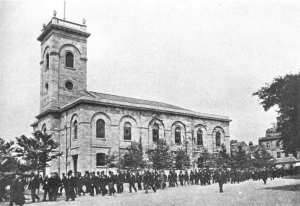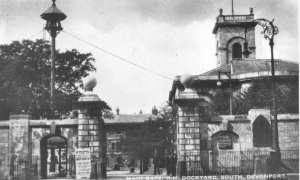|
OLD DEVONPORT
. UK |
||
|
© Brian
Moseley, Plymouth Webpage created: August 19, 2017 Webpage updated: May 15, 2019 |
||
|
ROYAL DOCKYARD CHAPEL OF SAINT LOE Situated just in side of the old Fore Street Gate, the Royal Dockyard Chapel of Saint Loe was the second oldest Church of England place of worship in the Town of Devonport.
The Royal
Dockyard Chapel of Saint Loe, Devonport. The Royal Dockyard Chapel was founded in 1700, just a short time after the commencement of the Royal Dockyard, and bore an inscription that it was built ~ by the generous and pious contributions of officers and seamen belonging to a squadron of men-of-war paid off in this yard (after 10 years expensive war with France); being propagated and carried on by the energy and religious endeavours of George St Loe, Esquire, commissioner of the said yard, and comptroller of the said pay. ~ It was forever after known as St Loe's (sic) Church A second aisle was later added by one of the incumbents, the Reverend Hughes, who let out the pews until the Government paid him the money it had cost him and appropriated the Chapel exclusively for the use of Naval and Dockyard personnel. A century later the Chapel had deteriorated so much that in September 1814 the order was given to have it demolished, the tower being pulled down on November 11th. In the meantime services had been transferred to the Ropehouses in South Yard. The foundation stone of the new Chapel was laid without ceremony on Thursday January 19th 1815. The name of the Commissioner of the Royal Dockyard at the time, Mr Robert Fanshawe, was engraved on the stone. Unfortunately it was soon found that the foundations had not been properly prepared and this delayed the completion of the building. It was opened for Divine Service on November 9th 1817. Designed by Mr Adams of East Stonehouse, the building was of hewn stone and cost £24,000, all of which was paid for by the Government. It had a tower of 85 feet in height in which was a peel of eight bells. The first six were cast by John Pennington of Lezant in Cornwall and were installed in 1770. The last two bells were added in 1866. The Chapel was capable of seating 2,000 worshippers, from the most senior Dockyard officers and their families in the nave to the naval and military officers sat in the gallery. Ratings and Dockyardees could sit or stand at the sides.
The tower of
the Dockyard Chapel was visible from An organ built by Lincoln was installed in about 1820. By 1889, 'in consequence of the time and wear' it was in need of extensive repair. It was also considered necessary to add some stops which were by then universally used in church organs. An announcement in the Western Morning News on Monday September 2nd 1889, inserted by the Admiral Superintendent of the Royal Dockyard and the Chaplain, the Reverend S A Shone, LL. D., announced that the cost was expected to be at least £200 but as the Lords Commissioners of the Admiralty had promised the sum of £100, the balance had to be found by voluntary subscriptions.
The organ in the Royal Dockyard Chapel. A memorial service was held in the Royal Dockyard Chapel on Thursday October 10th 1912 for the Commanding Officer and Crew of the HM Submarine "B2", which had been lost off South Foreland, Dover, on October 4th 1912 when she was cut in two by the liner "Amerika". Fifteen lives were lost and only one, the officer of the watch, was rescued. The Royal Dockyard Chapel was damaged in April 1941 during the Blitz on Devonport and the remains were demolished. Services continued to be held in the Church Hall in South Yard. In 1956 the Admiralty decided to use the Kelly College Mission Church of Saint Chad in Moon Street, Morice Town, which was soon to be brought within the walls of the expanded Dockyard.
|
||


